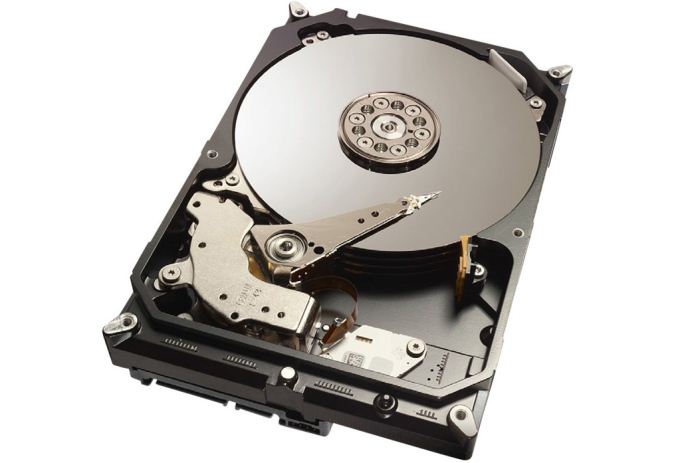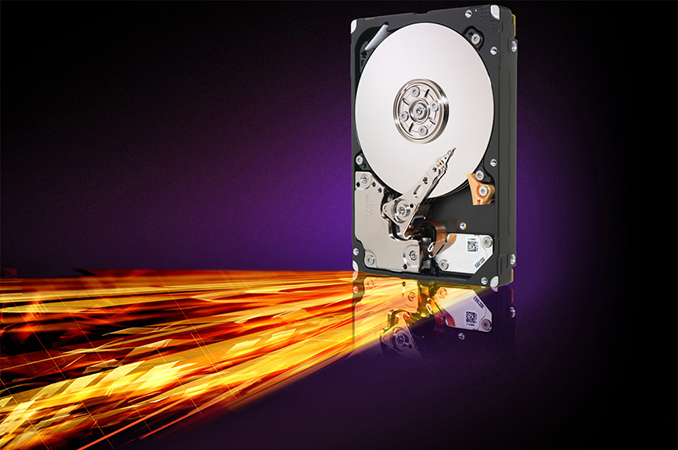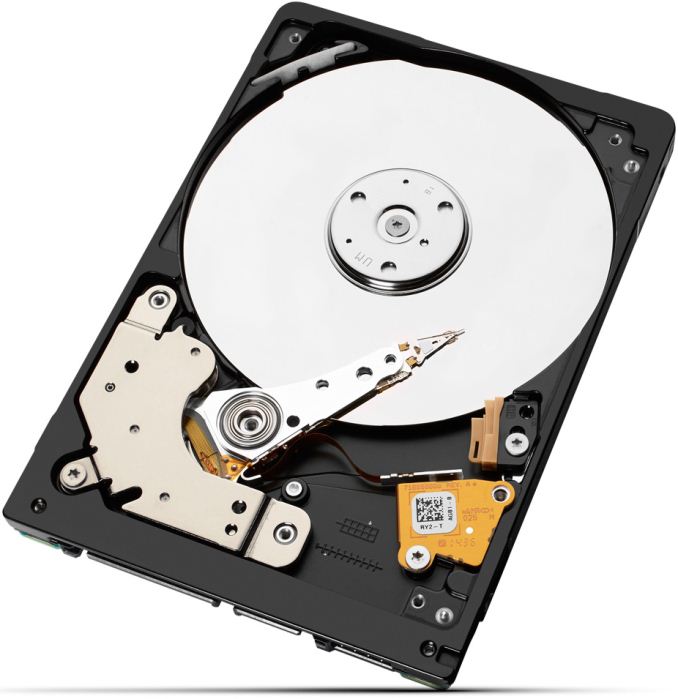Seagate Confirms Plans for 12 TB HDD in Near Future, 16 TB HDD Due in 2018
by Anton Shilov on January 30, 2017 2:00 PM EST
The CEO of Seagate has confirmed plans to release new nearline harddrives with 12 TB capacity in the coming months, and HDDs with 16 TB capacity over the course of the next several quarters. The latter are believed to be based on HAMR technology and the comment by the CEO essentially means that the company is on track with its next generation of heat assisted magnetic recording technology.
12 TB HDDs Incoming
Seagate’s CFO confirmed plans to release nearline HDDs with 12 TB capacity in early November, 2016. Last week Steve Luczo, CEO of Seagate, said that such drives had been evaluated by the company’s customers for about two quarters now and the feedback about the drives had been positive. He did not elaborate on the exact launch timeframe for the product, but given the fact that the drive is nearly ready, it is logical to assume that the 12 TB HDD should be announced formally in the coming weeks or months.
The hard drive maker has not revealed many details about its 12 TB Nearline HDD so far, but previously Seagate disclosed that this drive is filled with helium and is based on PMR technology, whereas last week the company implied that it uses eight platters. Keeping in mind that Showa Denko recently launched 1.5 TB platters for 3.5” drives, it is likely that Seagate uses eight of such platters for its 12 TB HDDs. In fact, Western Digital’s HGST Ultrastar He12 HDD with 12 TB capacity introduced last December comes with eight PMR disks as well.
“As you know, going from 8 to 10 to 12 to 16 [TB], you are going from six to eight disks, at least, on the nearline products,” said Steve Luczo, CEO of Seagate, during a conference call with investors and financial analysts.
16 GB HAMR HDDs in 12 to 18 Months
The 12 GB drive will be Seagate’s top-of-the-range model for enterprise and other demanding applications for quite a while and will become the company’s highest-capacity PMR-based drive. But, for the second time last week, the company mentioned 16 TB HDDs due in the next 12 to 18 months. Moreover, since such drives will be based on HAMR technology (Seagate discussed the feasibility of HAMR-based HDDs at 16 TB last year), they will cause a certain level of disruption on the market.
“During the next 12 to 18 months, we expect the nearline market to be diversified in capacity points for different application workloads, with use cases from 2 to 4 TB products for certain applications up to 16 TB for other use cases,” said Mr. Luczo.
Hard drives featuring heat-assisted magnetic recording technology will cost more to build compared to traditional HDDs because of the increased number of components and use of new materials. As a result, such drives will also be more expensive to actual customers. At present, we do not know specifics, but what Seagate says is that in the future the market of nearline HDDs will get more diverse and its lineup will get wider. In the past, the product stack used to remained similar, and as larger drives were introduced every year, previous-gen products were moved down the stack and low-capacity models discontinued. This may not be the case in the future and customers who need maximum capacity (i.e., who would like to store 3840 TB of data per rack and require 16 TB drives) in 2018 will probably have to pay more than they pay for leading edge HDDs today.
It is noteworthy that Seagate also mentioned 14 TB and 20 TB HDDs in the conference call, but without specifics, it does not sound like a good business to make assumptions about them. So far, the company has not explicitly announced any plans to release SMR-based 14 TB HDDs for specific workloads to compete against Western Digital’s Ultrastar He14.
Higher-Capacity Consumer Drives In Demand
Moving on with the comments made by the head of Seagate, we noticed that Mr. Luczo also mentioned higher-capacity HDDs for consumer applications. In particular, when talking about increasing amount of disks and heads per drive, CEO of Seagate indicated that the numbers are also increasing for consumer HDDs as well.
“We do think there [are] opportunities for more heads and disks on desktop and notebook, as people need higher capacity as well,” said Steve Luczo.
Keeping in mind that Seagate currently offers BarraCuda Pro desktop HDDs with 6 TB, 8 TB and 10 TB drives for consumers, and these drives use enterprise-class platforms (albeit with multiple changes). The remark by the CEO is an indication that the company will keep doing so in the future. Meanwhile it is interesting to note that the head of Seagate also mentioned mobile drives with increased number of platters and heads, hinting on increasing demand for higher-end 2.5” HDDs with more than one platter. At present, Seagate offers 5TB drives in a 2.5-inch form factor, although these come in at 15mm and typically tend not to fit in most mobile environments.
Related Reading:
Source: Seagate
















31 Comments
View All Comments
BrokenCrayons - Monday, January 30, 2017 - link
Interesting news indeed. A long time ago, I fielded a storage solution for a customer that used nearly 150 SCSI drives to offer almost 1TB of capacity for a company's server room (you know, before we started calling them data centers, heh) for an ungodly amount of money. We've come an awfully long way since then.DanNeely - Monday, January 30, 2017 - link
24 years ago I had a computer with a 120MB HDD, which I thought was huge: Nearly 300x 360k 5.25 floppies of storage, or more than 80 of the expensive 3.5" 1.44mb sort! Then I got a CD drive. Today I have a a TB of flash in my gaming PC and a pair of 6TB HDDs in my NAS.I suspect both will last me until at least 2020 when I'll be due for a new gaming PC and the Server 08r2 Windows build underlying my WHS2011 NAS goes end of life. Whatever replaces the latter might well be my last HDD purchase ever, due to projections suggesting the mid 2020's are when SSDs will drop below HDDs in cost per GB. Once the price gap gets within ~$100/HDD (or equivalent) or so switching over just to replace a largish MITX box with something NUC-Router sized will start looking rather attractive. 2020's probably going to be too soon for that though.
BrokenCrayons - Tuesday, January 31, 2017 - link
My situation is pretty similar to yours. The first PC that I bothered to tinker with much was a 386sx at 16MHz. It shipped with a 40MB drive and I added a 60MB hard disk when it became available. I recall being extremely impressed with myself over the idea of having 100MB of total storage space.Like you, I don't see myself purchasing another hard drive in the future. Both of my laptops use solid state drives and there's a 1TB drive in my old netbook which I'm using as a NAS box. It's using less than 100GB of that space and there's just not a big enough cost gap for capacity to warrant using a HDD in any system at this point. Of course, people with less modest storage requirements might still have a need, but I think perhaps around 2020 we'll be largely done with using hard drives across the industry as a whole.
DanNeely - Wednesday, February 1, 2017 - link
I've got ~3TB on my NAS (2x 6TB in RAID0 equivalency). Mostly backups of my active systems and snapshots of retired HDDs/computers. Based on historical trends I expect I'll be near capacity again in 3 years when I need to replace it anyway.Bulk storage (eg home nas, cold data in the cloud, etc) isn't expected to hit cheaper on flash until the mid 2020's; so we're probably a decade out industry wide. OTOH for end user devices 2020 might be doable. The problems being that below a minimum capacity lack of parellelism causes SSD perf to fall off a cliff, making the cheapest HDD cheaper than the cheapest non total crap SSD; and that there are a lot of people who only look at cheap laptops in a boxmart see 500gb > 128gb, and know the first is obviously better. The sales man is clearly trying to scam them pushing the second. *sigh*
Gigaplex - Tuesday, January 31, 2017 - link
And yet 4 years ago I bought a bunch of 3TB drives for an array. They're out of warranty so I'd like some new ones. I'm used to replacing drives every 3-5 years at the same price point, getting a capacity increase in the process. Much to my annoyance, the drives I bought are still exactly the same price. There has been no movement in price, the only thing that has changed is that larger, more expensive drives are available.beginner99 - Tuesday, January 31, 2017 - link
Exactly. When I bought my 2TB HDDs like 5.5 Years ago, they cost $99. And now they can be had for maybe $80 here. Yeah that's still 20% less but little compared to previous times. Shows how the whole market is stagnating, not just CPUs.DanNeely - Tuesday, January 31, 2017 - link
You're never going to see 3.5" old drives slump much below $100 because at that price level manufacturing/etc costs eat almost the entire price. Capacities that small are mostly drives made years ago that have been sitting in a warehouse for years unsold. At the barely making any money price level what we do get is a lot more capacity for the dollar . You can get 4TB for $105 on Newegg today or 3TB for $80 ($70 if you're willing to accept a no-name model instead of Seagate or HGST).DanNeely - Tuesday, January 31, 2017 - link
You didn't say exactly which model you bought; but the Camel Camel Camel price charts for several 3TB drives from around that era all show substantial price drops over the last few years. My first thought is to suspect you found a crazy sale that wasn't captured; and those sort of sales are rarely repeated afterwards, especially for old stuff.http://camelcamelcamel.com/Red-3TB-Hard-Disk-Drive...
http://camelcamelcamel.com/Model-Seagate-3-5-Inch-...
http://camelcamelcamel.com/Seagate-Desktop-3-5-Inc...
dgingeri - Monday, January 30, 2017 - link
When it comes to fading technology, when it comes down to one manufacturer expanding on it, it is on its way out. This was true for the floppy drive (first the 2.88MB floppy and later the LS-120 superdisk) and external mechanical drives (the 750MB Zip drive and 2GB Jazz drive) and even backup tapes (LTO-5, 6, and now 7) as they all were products that required heavy investments and had such little returns they nearly wiped out their makers. Seagate is going to continue to research into bigger drives and eventually fall into bankuptcy, while WD gets into the SSD field (their purchase of Sandisk and HGST show this) and manages to survive. They'd be better off spending research dollars on SSD technology.stephenbrooks - Monday, January 30, 2017 - link
Except it's not just one manufacturer, because Seagate will be the _2nd_ manufacturer to produce a 12TB HDD, after Western Digital (as it says in the article).